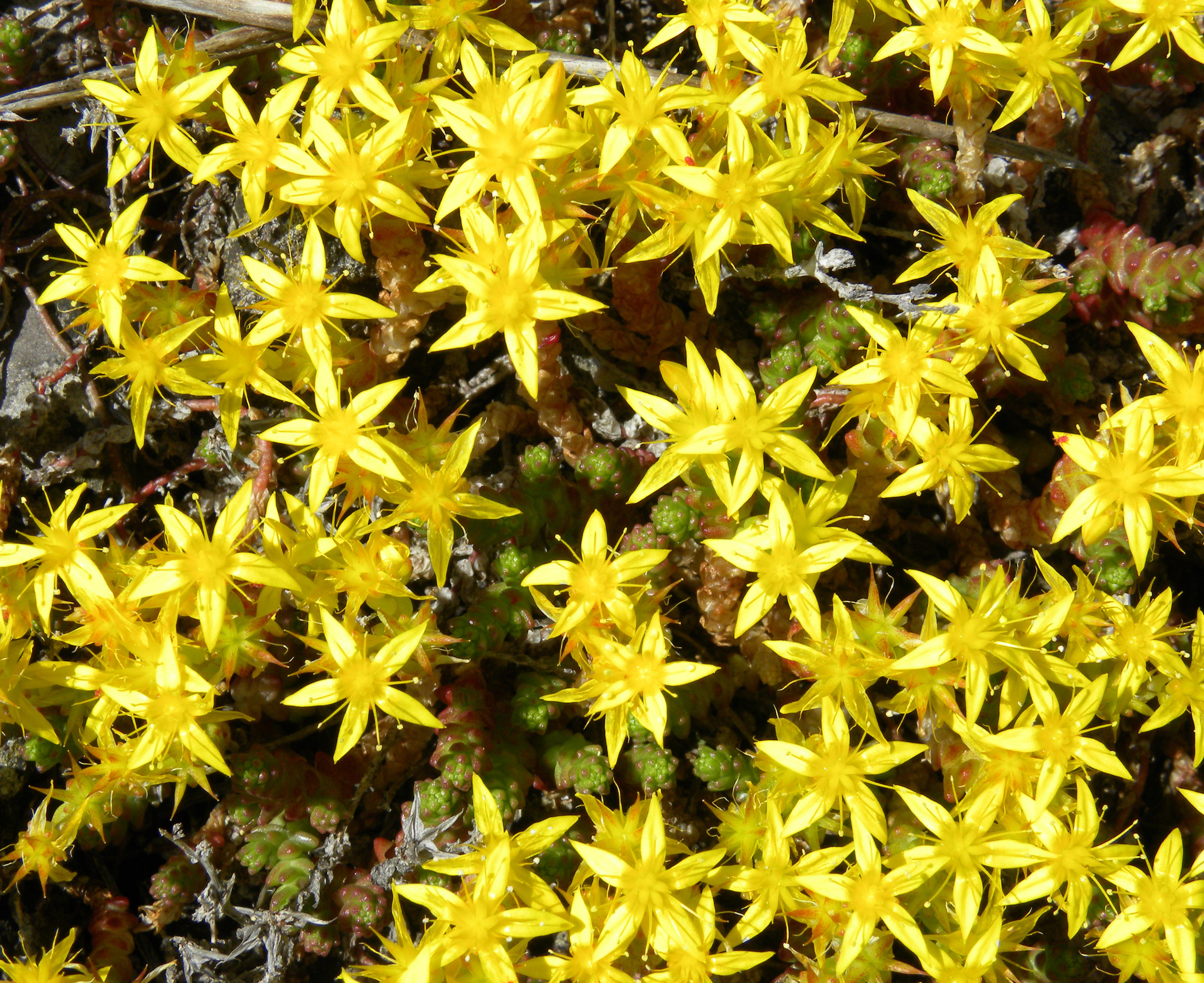Sedum Acre on:
[Wikipedia]
[Google]
[Amazon]
 ''Sedum acre'', commonly known as the goldmoss stonecrop, mossy stonecrop,Dickinson, T.; Metsger, D.; Bull, J.; & Dickinson, R. (2004) ROM Field Guide to Wildflowers of Ontario. Toronto:Royal Ontario Museum, p. 243. goldmoss sedum, biting stonecrop and wallpepper, is a perennial
''Sedum acre'', commonly known as the goldmoss stonecrop, mossy stonecrop,Dickinson, T.; Metsger, D.; Bull, J.; & Dickinson, R. (2004) ROM Field Guide to Wildflowers of Ontario. Toronto:Royal Ontario Museum, p. 243. goldmoss sedum, biting stonecrop and wallpepper, is a perennial
 ''Sedum acre'', commonly known as the goldmoss stonecrop, mossy stonecrop,Dickinson, T.; Metsger, D.; Bull, J.; & Dickinson, R. (2004) ROM Field Guide to Wildflowers of Ontario. Toronto:Royal Ontario Museum, p. 243. goldmoss sedum, biting stonecrop and wallpepper, is a perennial
''Sedum acre'', commonly known as the goldmoss stonecrop, mossy stonecrop,Dickinson, T.; Metsger, D.; Bull, J.; & Dickinson, R. (2004) ROM Field Guide to Wildflowers of Ontario. Toronto:Royal Ontario Museum, p. 243. goldmoss sedum, biting stonecrop and wallpepper, is a perennial flowering plant
Flowering plants are plants that bear flowers and fruits, and form the clade Angiospermae (), commonly called angiosperms. They include all forbs (flowering plants without a woody stem), grasses and grass-like plants, a vast majority of ...
in the family Crassulaceae
The Crassulaceae (from Latin ''crassus'', thick), also known as the stonecrop family or the orpine family, are a diverse family of dicotyledon flowering plants characterized by succulent leaves and a unique form of photosynthesis, known as Cr ...
. It is native to Europe
Europe is a large peninsula conventionally considered a continent in its own right because of its great physical size and the weight of its history and traditions. Europe is also considered a subcontinent of Eurasia and it is located enti ...
, but also naturalised in North America, Japan and New Zealand
New Zealand ( mi, Aotearoa ) is an island country in the southwestern Pacific Ocean. It consists of two main landmasses—the North Island () and the South Island ()—and over 700 List of islands of New Zealand, smaller islands. It is the ...
.
Description
Biting stonecrop is a tuftedevergreen
In botany, an evergreen is a plant which has foliage that remains green and functional through more than one growing season. This also pertains to plants that retain their foliage only in warm climates, and contrasts with deciduous plants, which ...
perennial
A perennial plant or simply perennial is a plant that lives more than two years. The term ('' per-'' + '' -ennial'', "through the years") is often used to differentiate a plant from shorter-lived annuals and biennials. The term is also wide ...
that forms mat-like stands some tall. For much of the year the stems are short, semi-prostrate and densely clad in leaves. At the flowering time in June and July, the stems lengthen and are erect, somewhat limp and often pinkish-brown with the leaves further apart. The leaves are alternate, fleshy and shortly cylindrical with a rounded tip. They are also sometimes tinged with red. The starry flowers form a three to six-flowered cyme. The calyx has five fleshy sepals fused at the base, the corolla consists of five regular bright yellow petals, there are ten stamens, a separate gynoecium and five pistils. The fruit consists of five united, many-seeded follicles. The leaves contain an acrid fluid that can cause skin rashes.
Habitat
Biting stonecrop is a low-growing plant that cannot compete with more vigorous, fast-growing species. It is specially adapted for growing on thin dry soils and can be found on shingle, beaches, drystone walls, dry banks, seashore rocks, roadside verges, wasteland and in sandy meadows near the sea.Cultivation
Biting stonecrop spreads when allowed to do so, but is easily controlled, being shallow-rooted. It is used in hanging baskets andcontainer garden
Container gardening or pot gardening/farming is the practice of growing plants, including edible plants, exclusively in containers instead of planting them in the ground. A container in gardening is a small, enclosed and usually portable object ...
s, as a trailing accent, in borders
A border is a geographical boundary.
Border, borders, The Border or The Borders may also refer to:
Arts, entertainment and media Film and television
* ''Border'' (1997 film), an Indian Hindi-language war film
* ''Border'' (2018 Swedish film), ...
, or as groundcover. This plant grows as a creeping ground cover
Groundcover or ground cover is any plant that grows over an area of ground. Groundcover provides protection of the topsoil from erosion and drought.
In an ecosystem
An ecosystem (or ecological system) consists of all the organisms and th ...
, often in dry sandy soil
Soil, also commonly referred to as earth or dirt, is a mixture of organic matter, minerals, gases, liquids, and organisms that together support life. Some scientific definitions distinguish ''dirt'' from ''soil'' by restricting the former ...
, but also in the cracks of masonry
Masonry is the building of structures from individual units, which are often laid in and bound together by mortar; the term ''masonry'' can also refer to the units themselves. The common materials of masonry construction are bricks, building ...
. It grows well in poor soils, sand, rock gardens, and rich garden soil, under a variety of light levels.
References
{{Taxonbar, from=Q156823acre
The acre is a unit of land area used in the imperial and US customary systems. It is traditionally defined as the area of one chain by one furlong (66 by 660 feet), which is exactly equal to 10 square chains, of a square mile, 4,840 square ...
Flora of Europe
Medicinal plants
Plants described in 1753
Taxa named by Carl Linnaeus
Flora of North Africa